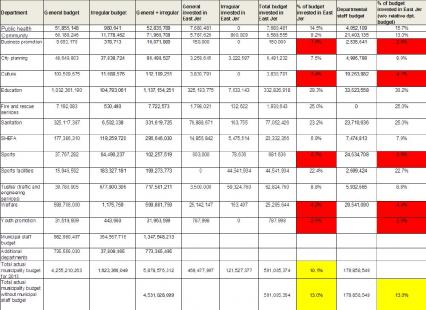Jerusalem Municipality Budget Analysis for 2013: Share of Investment in East Jerusalem
December 2014
This document presents the relative share invested by the Jerusalem Municipality in East Jerusalem, in general and according to departmental budgets, as evidenced in the Municipality’s actual budget data for 2013. This document follows up on preliminary data published by Ir Amim for Jerusalem Day in May 2014. With the Municipality’s full performance report (trial balance) now published (October 2014), it is possible to present a complete analysis.
The basis for this comparative budget analysis is actual budget data for 2013, including both municipal budgets and state budgets funneled through the Municipality; for example, salaries for teachers, social workers, and public health nurses. The calculation also takes into account the “additional irregular budget”.
This budget is mainly intended to fund large, high investment infrastructure projects, and is brought to the City Council for approval only in the middle of the year, after the different government offices have decided the sum of their budget to be allocated to municipalities. Once the money is transferred to a municipality, distribution of funds between various municipal departments falls under the municipality’s authority, independent of the government.
The relative share of the Jerusalem Municipality’s budget invested in East Jerusalem should be compared, at the very least, in relation to the percentage of the Palestinian population living in East Jerusalem. According to estimates of the Central Bureau of Statistics (Israel), the average population of Jerusalem during 2013 totaled 822,600 people, 303,900—or about 36.9%—of them Arabs. According to the Population Registry of the State of Israel, Jerusalem’s non-Jewish population totaled about 371,844.[1]
As such, the Municipality’s relative investment in East Jerusalem should have been, at the least, 37% of its total budget given this portion of the city is among the poorest and most neglected areas under Israeli jurisdiction. As of 2012, 75.3% of the Arab residents in the Jerusalem district, and 82.2% of the children, were living under the poverty line.[2] In this situation, we would expect the budget to favor East Jerusalem, and investments in its residents a share even larger than their percentage in the population. As we will see, this is far from being the case.
Main findings
Calculations of the Jerusalem Municipality’s relative investment in East Jerusalem were based on three models:
1. Comparing the sum of known investments in East Jerusalem to total budget: only 10.1% of the municipal budget is invested in East Jerusalem.
2. A “softer” model, of comparing the sum of known investments in East Jerusalem to total budget, subtracting the “administrative staff” budget (the part of this budget that is invested in East Jerusalem is known to be low; removing it completely raises the investment ratio): only 13% of the municipal budget is invested in East Jerusalem.
The municipal staff budget includes the office of the mayor, the office of the general director of the Jerusalem Municipality, legal counsel, city comptroller, ceremonies, deputy mayors’ salaries, accounting department, etc. While the part of this budget invested in East Jerusalem is known to be low, subtracting it entirely raises the investment ratio.
3. According to the softest model—comparing the sum of known investments in East Jerusalem to the total budget, without “administrative staff” and departmental staffs: only 13.6% of the municipal budget is invested in East Jerusalem.
According to even the softest of the three calculations, the percentage of relative investment in East Jerusalem by the Jerusalem Municipality is low. Between 10.1% and 13.6% of the city budget has been invested in 37% of its residents. Furthermore, in five different departments the Municipality’s relative investment is smaller than 5% of the budget. In the culture department, the share of investment is a mere 3.4%; in the sports department, 0.6%; in the welfare department, 4.2%; in the business promotion department, 1.5%; and in the youth promotion department, 2.5%. The scale of investment from the welfare department is astounding when considering the high poverty rates in East Jerusalem. So too is the percentage of investment in youth promotion—mainly targeting dropouts—considering the fact that East Jerusalem has a dropout rate of 13%, in contrast to the 1% dropout rate in West Jerusalem.
The Municipality generally denies the veracity of these figures, but fails to produce alternative data to support its claims.

This budget analysis was conducted with the support of Dr. Meir Margalit, who held the East Jerusalem portfolio in the previous City Council.[3 ]
------------------------
[1] Population Registry data, 31.12.12. The data for the non-Jewish population under the Ministry of the Interior’s Population Registry includes Muslims and Christians, including the small share of this population that resides in West Jerusalem as well as residents bearing the legal right to live in Jerusalem who do not actually reside in it. Data from 2009 shows that 99% of the Palestinian population resides in East Jerusalem.
[2] The National Insurance Institute of Israel, Poverty and Social Gaps in 2012, annual report:
https://www.btl.gov.il/English%20Homepage/Publications/Poverty_Report/Do....
[3] Only funds that contribute to development of East Jerusalem and the welfare of its citizens were included in calculation of funds invested in East Jerusalem. For example, the budget article “printing study books”, under the MANHI budget, which serves for printing study books censored by the Municipality, was deducted, as was the budget article “enforcement of constriction laws” under the licensing and inspection department, which applies to home demolitions.



